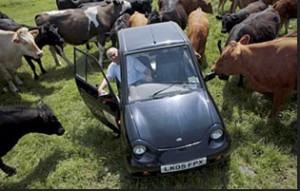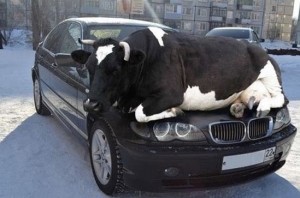Does Ireland Want More Cows or More Cars – It Can’t Have Both
When you tell someone that they cannot have something that they want, they tend to revert to the behavior of two-year-olds – whining or getting angry or even throwing a fit. One sometimes gets that reaction in conversations about climate change if one dares suggest that they are going to have to do without some creature comfort or object of pleasure or economic benefit, with a pay off only for future generations. Nevertheless, that is where we find ourselves because of the Irish government policy or strategy called Harvest 2020.
Under Harvest 2020, the government has committed to increasing the size and output of the national dairy herd by 50% starting this year. There are other components to Harvest 2020, including for beef cows and fisheries, but the significant increase in milk production is perhaps the most problematic. With the dairy herd expansion, EPA estimates that there will be a 12% rise in agricultural emissions by 2020, only five years away. Already the agricultural sector is responsible for about 33% of Ireland’s total GHG emissions, mainly in the form of methane. In other EU countries agriculture contributes about 9% of GHGs.
Friends of the Earth
To clear the air of some smoke that billows out of the government and agriculture lobbying organizations, we often hear of purported advances from the agriculture sector in reducing levels of CO2, while they know that the problem in agriculture is methane, a much more potent, though shorter-lived GHG. Moreover, increased dairying will lead to a rise in imported animal feed, and higher levels of CO2. The pleas to increase food production in Ireland to feed the starving 9 billion people by 2050, especially those in developing countries, is almost cynical. Poor people in developing countries do not need, and do not eat, expensive beef, cheese and butter. Moreover these people lack proper food in large part because they need better distribution of what already is produced. The plea for food security plays on the fears of a lack of food that drove, in part, the post-war founding of what has become the EU, yet now obesity is more of a problem than lack of food. Finally, when they speak of the agriculture community, they hope to raise the nostalgic image of the impoverished west of Ireland family farm, with a thatched cottage, a few cows and sheep and turf carts, embodied in John Hines postcards and beloved by various politicians. Yet the agriculture community, and certainly the lobbying organizations, are dominated by large commercial farming operations, where consolidation is leading to herds that are doubling in size, along with the land and equipment to match. The small “traditional” family farm is disappearing.
Besides all the smoke, there is a very loud silence from the government and agricultural lobby on how this significant increase in GHG methane is going to be offset or paid for. They claim that operational efficiencies will help, but there is scant evidence of these practices actually being implemented, and a recent report from Teagasc recognises that full participation by farmers in abatement measures is “unlikely to materialise in the absence of targeted incentivisation measures.” In other words commercialised farming is not going to do what is needed to reduce methane emission unless someone else pays for it. With regard to grassland sequestration, and other forms of abatement, the Teagasc report acknowledges that: “Until the potential of these new measures has been fully analysed, it is difficult to anticipate the abatement potential or cost-effectiveness, of each of these mitigation options.” These measures remain speculative while the expansion of the dairy sector gets clearer.
Viralnova
So where is the real cost going to be placed? Perhaps other sectors, such as transport, will be forced to absorb the added costs. Perhaps the government will limit people to driving their cars on certain days, at least in urban areas where there is public transport. If not, perhaps the government can restrict commercial heavy goods vehicle traffic, including large trucks hauling milk and cheese and beef to the UK and continent. Perhaps any increase in herds should be banned until after any projected efficiencies have been fully implemented. Perhaps the public will be forced to carry the costs, through taxes or cutbacks in public benefits
Perhaps not.
What we all want and deserve, and have been denied, is a full, open engagement between the public, government, and all sectors on specifically what has to be done and who is going to sacrifice. This does not mean a bureaucratic consultation on an assessment document. The government must surely see how it has dramatically failed to fully engage the public in the need for water charges and meters, and wind farms, and the consequences of those failures.
As An Taisce has argued, “A national carbon budget requires real political leadership, because excess emissions by one sector will have to be balanced by less for other sectors.” See, Climate Change Bill.
Duncan Clark has recently provided a useful assessment of the interplay between a carbon budget and other GHGs. In it he points out, sensibly, that we can increase our use of fossil fuels, at least for a limited time and limited extent, if we reduce production of methane and other non-CO2 GHGs. On the other hand, if we let global warming to increase because we continue to raise the levels of methane and other non-CO2 GHGs, then we have a much smaller carbon budget left to tap into.
As we said, do we want more cows or cars? Pretending we can have both is a reliance on miracles that is self-delusional.
Sources
European Commission, Agriculture and climate change (last updated 02 March 2015). ec.europa.eu/agriculture/climate-change/index_en.htm
John Sweeney, “Harvest 2020,” in ieBLOG of irish environment (July 2012). www.irishenvironment.com/blog/harvest-2020/
Ivan Yates, “Now we must copy Kiwis at farming to be real world-beaters,” Irish Independent (27 March 2015). www.independent.ie/opinion/columnists/ivan-yates/now-we-must-copy-kiwis-at-farming-to-be-real-worldbeaters-31095528.html
An Taisce, Food Harvest 2020 www.antaisce.org/issues/food-harvest-2020
An Taisce, Climate Change Bill is ‘designed to fail’ – Urgent improvements required (23 Jan 2015). See link in citation above
An Taisce, Minister Coveney and ICOS should guarantee that rising agriculture emissions will not cost taxpayer (17 Dec 2014). www.antaisce.org/articles/minister-coveney-and-icos-should-guarantee-rising-agriculture-emissions-will-not-cost
Duncan Clark, “How much of the world’s fossil fuels can we burn?” The Guardian (25 March 2015). www.theguardian.com/environment/keep-it-in-the-ground-blog/2015/mar/25/what-numbers-tell-about-how-much-fossil-fuel-reserves-cant-burn
Teagasc, Interim report on greenhouse gas emissions from Irish agriculture: Teagasc submission made in response to the discussion document on the potential for Greenhouse Gas (GHG) mitigation within the Agriculture and Forestry sector (25 March 2015). www.teagasc.ie/search/index.asp?q=Harvest%202020%20soil%20capture
EDITOR’S UPDATE (2 April 2015):
Darragh McCullough, “Farming will not be held back by green targets says [Irish Minister] Coveney,” Irish Independent (1 April 2015). www.independent.ie/business/farming/farming-will-not-be-held-back-by-green-targets-says-coveney-31105492.html




No comments yet, add your own below